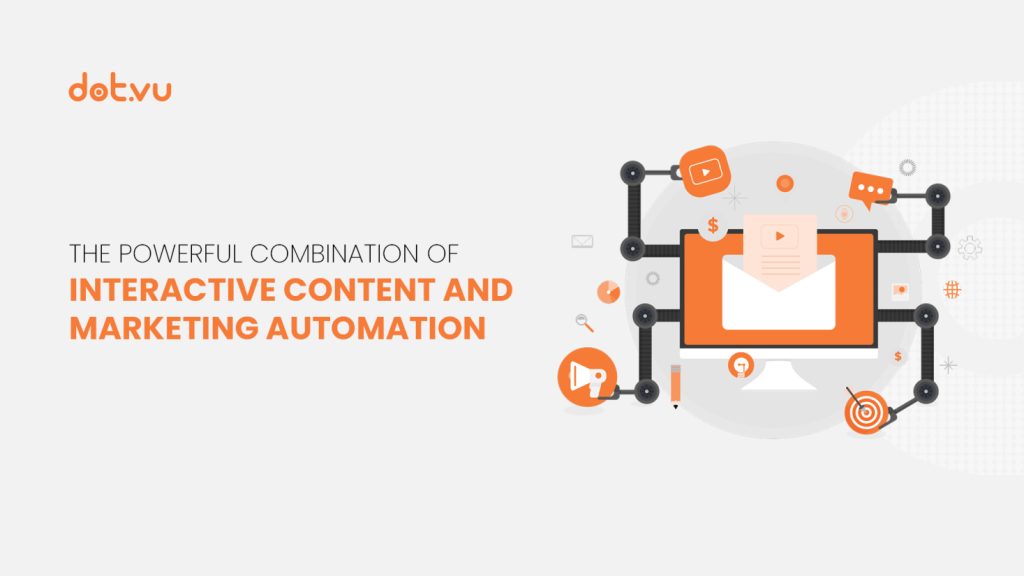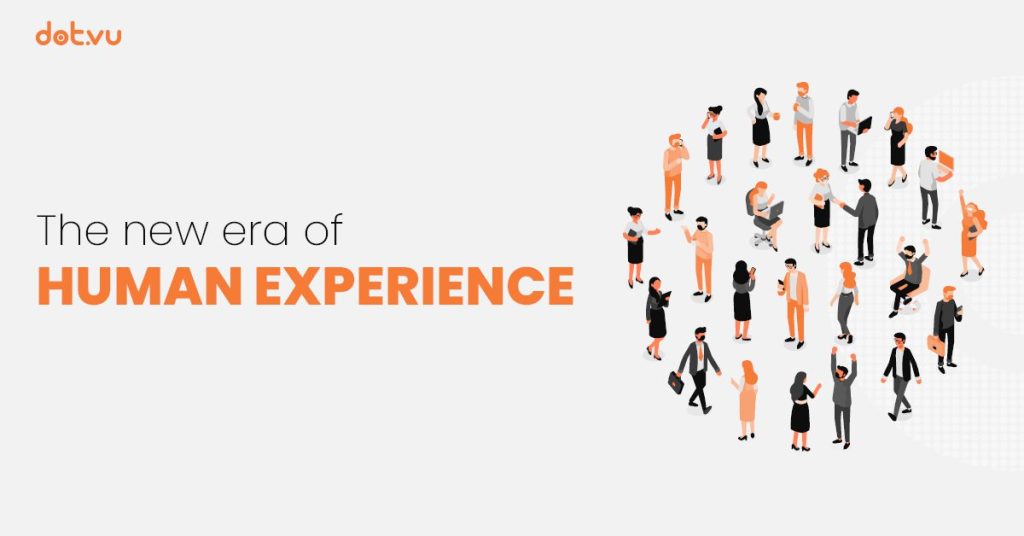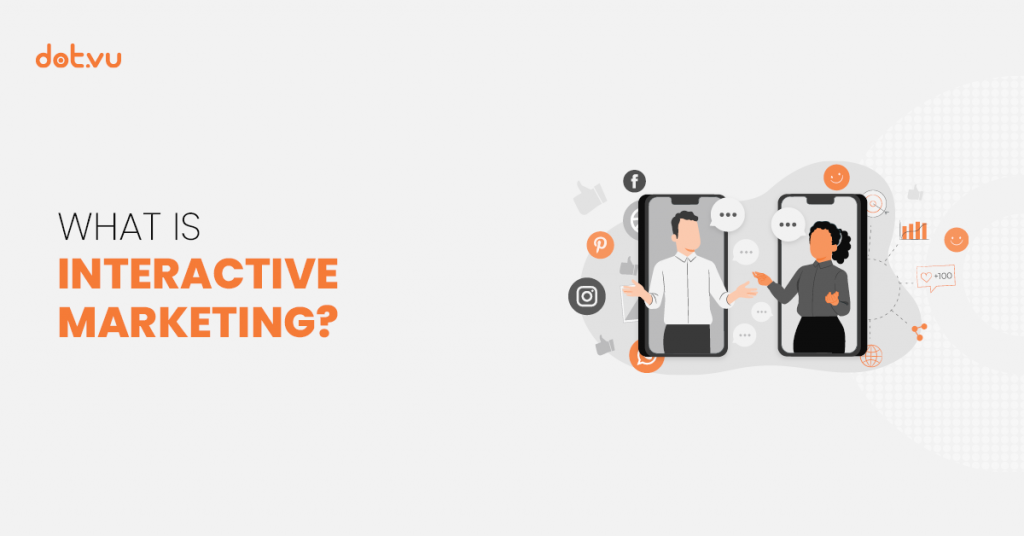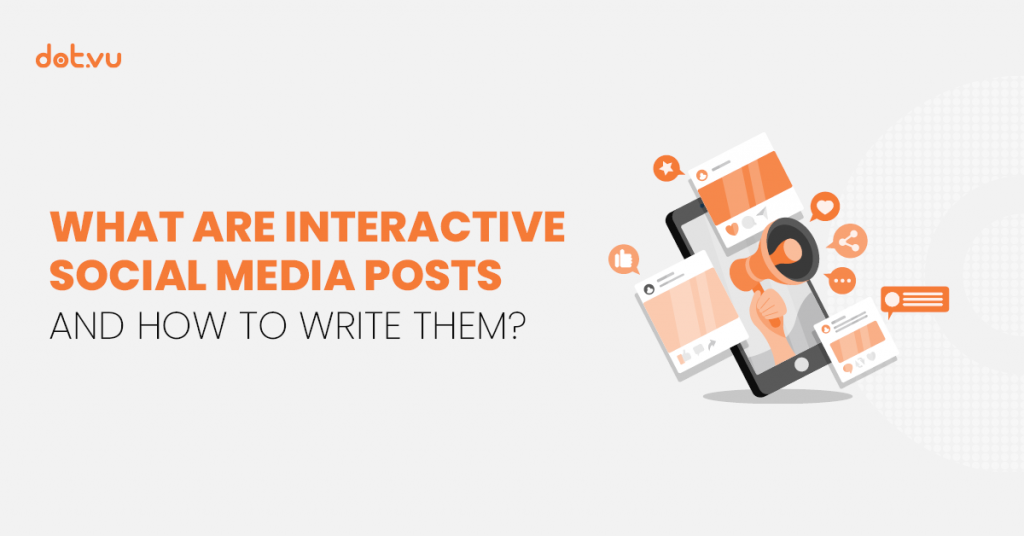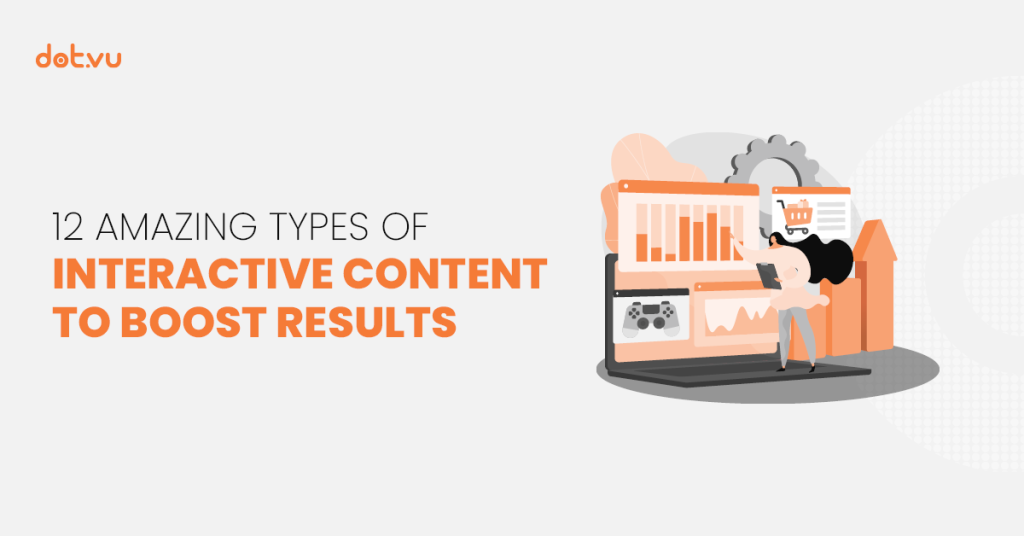
Before we get into our core subject, 12 types of Interactive Content, let’s take a moment to understand what Interactive Content truly is.
Imagine starting your day procrastinating on Buzzfeed, taking their new quiz about what type of salad you are (yes, that actually exists). You eventually start working, researching, and reading Interactive Infographics for the proposal you will present later today. Finally, a dreamy flight offer to China appears on your Facebook feed. However, the price is not in your currency, so you quickly look up a currency converter to see how affordable the offer is.
Just think about it: these seemingly everyday activities share a common thread. Beyond the occasional bout of procrastination, they all involve different types of Interactive Content.
What are the most popular types of Interactive Content to implement in your organization? Jump straight to your preferred section:
- Interactive Quizzes
- Interactive Assessments
- Guided Selling
- Interactive Videos
- Social Interactive Content
- Online Advent Calendars
- Marketing Games
- Interactive Conversation
- Interactive Inforgraphics
- Interactive Flipbooks
- Interactive Calculators
- Interactive Popups
What is Interactive Content exactly?
Interactive Content is online content where the customer actively participates rather than passively consuming it. In other words, with Interactive Content, customers enter the story and influence the results. So, it creates an Interactive Experience for the viewer, with the content becoming more memorable.
Interactive Content can be anything that requires the viewers to take action. Through technology, they become a part of the story. We’ve been seeing more and more brands shift toward interactive websites and honestly, it makes sense. They’re way more engaging and leave a stronger impression. Here’s a post we wrote that breaks it all down.
Related: What is Interactive Content?
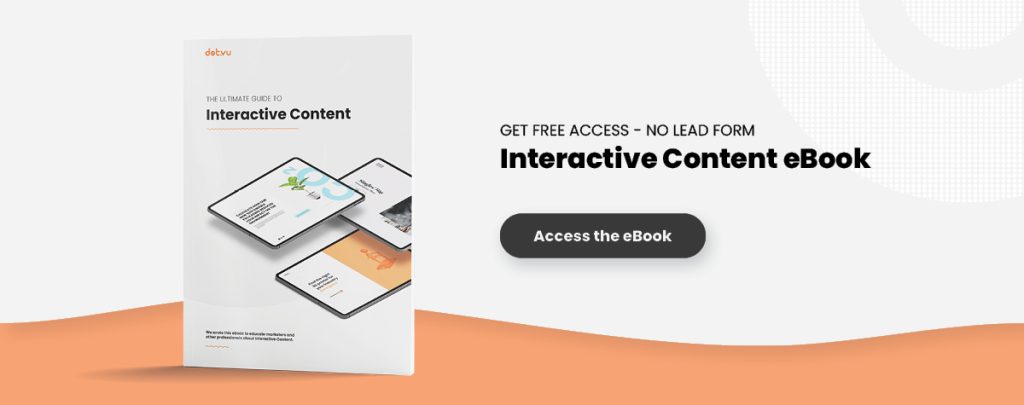
Why is it important to create content that is interactive?
Because Interactive Content solves several problems that digital marketers face:
- People’s attention spans are short in a hyperactive online world. Interactive Content captivates users’ attention better than regular static content and keeps people’s attention for longer.
- It’s harder to stand out on the Internet now than before. Interactive Content is still relatively new and makes you stand out with engaging, personalized, and memorable experiences.
- It’s harder to attain people’s contact information with an opt-in form. Interactive Content plays with people’s curiosity. When you offer personalized results, people are more likely to fill out your lead form as they get an unforgettable and unique experience out of it.
Given the impact of Interactive Content in today’s digital marketing landscape, you might already be familiar with it. Let’s find out – have you used any of these Interactive Content formats in your strategies? Share your experience with us in this quick poll.
12 Amazing types of Interactive Content to boost results
In the following sections, you can learn more about the most popular Interactive Content types. You can easily replicate any of these Interactive Content examples with Dot.vu.
1. Interactive Quizzes
An Interactive Quiz is a type of Interactive Content that is usually short and easy to take. It challenges, entertains, and engages participants, and, in the end, it provides results based on their replies. An example of a quiz could be “Are you a real Harry Potter fan?’. Quizzes are shareable and taggable on social media due to their light and often humorous content. Quizzes are also excellent for boosting lead generation.
There are different types of marketing quizzes, such as knowledge quizzes, personality quizzes, trivia quizzes, etc. You can also add a contest to your quiz to incentivize participation.
Main benefits of Quizzes: increase awareness, boost engagement, improve lead generation
Example: This is a Drag and Drop Quiz with Rewards, a simple yet engaging experience to offer visitors a break from boring marketing content.
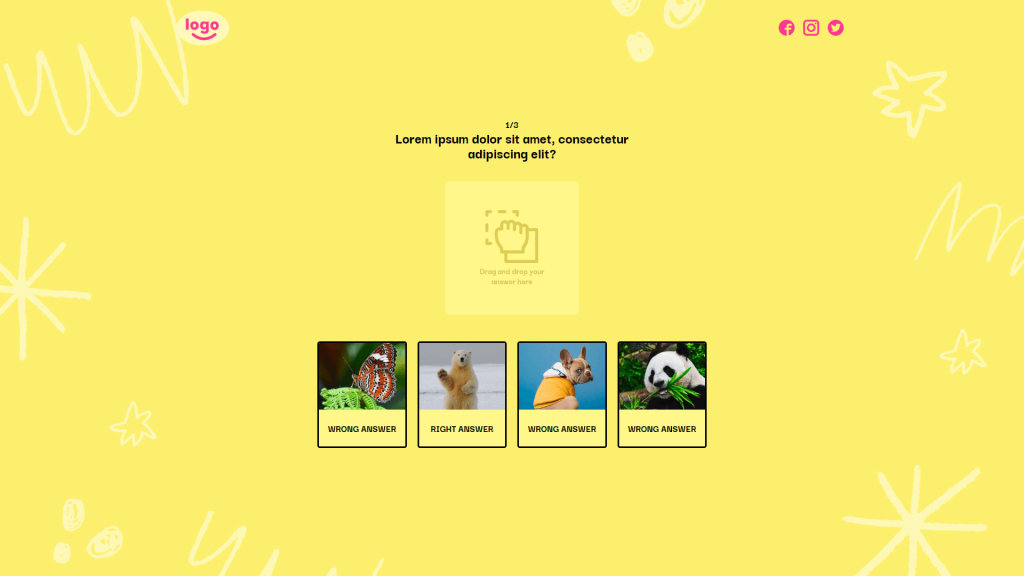
2. Interactive Assessments
Assessments are great Interactive Content examples that provide personalized feedback to the users. Assessments can suggest to users how to improve specific skills or which outcome would be best for them.
Interactive Assessment includes questions about a specific topic, like how people work, spend their time, or test their knowledge in a field. Similar to quizzes, they are also optimal for gaining new leads and growing your email list.
Moreover, Interactive Assessments are great for learning more about your audience. All the answers provided by potential customers throughout the Interactive Assessments can be used later on for retargeting. It helps you get to know your client’s preferences, interests, strengths, and weaknesses.
Finally, Interactive Assessments are great for B2B companies because they can help you provide background knowledge to your sales team. So, once a potential customer books a demo, your sales team is aware of what they need, their preferences, and so on. Therefore, they can tailor their sales pitch based on the answers the potential customers gave. Hence, Interactive Assessments are great Interactive Content types to increase sales.
There are different types of Interactive Assessments, such as knowledge assessments, skill assessments, educational assessments, and so on.
Main benefits of Interactive Assessments: boost engagement, educate your audience, improve lead generation, collect valuable data, and boost sales
Example: This example is a 3-Category Assessment to help customers evaluate their knowledge or skills.

3. Guided Selling
There are many different types of Guided Selling, such as Product Recommenders, Solution Builders, Gift Finders, etc.
These Interactive Content examples are the future of online shopping. Product Recommenders, for instance, allow you to engage with users by asking questions about their needs and preferences. Based on the responses, the Guided Selling experience will suggest products that best fit their needs. This versatile tool isn’t limited to any specific industry; it benefits retailers, webshops, and even SaaS solutions, serving as a powerful means to engage clients and drive sales.
Solution Builders, on the other hand, are Interactive Content types where users will answer a series of questions about what features, components, or add-ons they would like to add to their custom-built solution. The Interactive Experience will then propose a custom-built service, product, or solution according to their responses.
Guided Selling experiences are great for boosting sales because they help potential customers find exactly what they are looking for. Moreover, Guided Selling experiences are known to improve customer satisfaction and reduce returns.
Main benefits of Guided Selling experiences: Uncover customer needs, boost engagement, boost sales, collect valuable data, and increase customer satisfaction
Example: This Electronics Product Recommender is like a fun quiz for online shoppers. Answering just a few questions, they get recommendations for the best laptops based on their needs and budgets.

4. Interactive Videos
In an Interactive Video, like in all other types of Interactive Content, viewers participate actively in the Interactive Experience by clicking, answering questions, or making decisions. There are different types of Interactive Videos.
For example, in a Shopping Video, viewers can click on hotspots to learn more about the products they are interested in. They can also add the products directly to their shopping baskets. In a Branching Video, viewers can decide what happens next, so they become a part of the story. An Interactive Video Quiz, on the other hand, can be used to educate your audience on a specific subject, and then quiz them at the end to boost information retention and engagement.
The benefits of Interactive Videos highly depend on which types of Interactive Videos you are interested in. For example, Shopping Videos are amazing to boost sales, while Branching Videos are great to increase awareness and engage your audience.
Main benefits of Interactive Videos: increase awareness, boost engagement, educate your audience, boost sales
Example: This compelling Interactive Video is designed to help you boost sales on Black Friday.
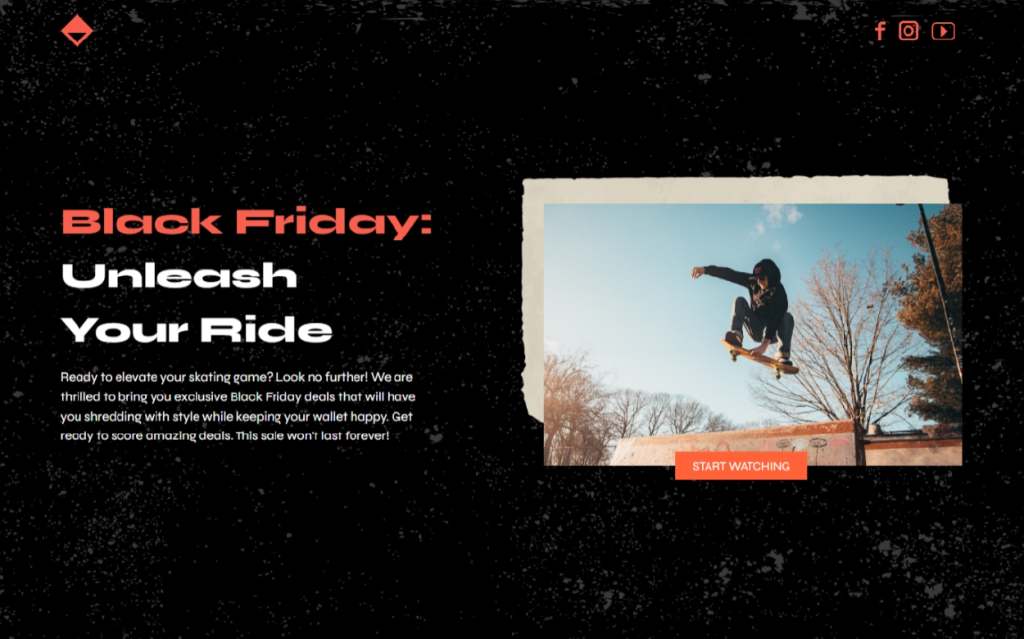
5. Social Interactive Content
Social Interactive Content is a special type of Interactive Content that is based on social sharing. The goal of these Interactive Content examples is to encourage participants to create their own Interactive Experiences and share them with friends and family on social media.
To explain it in words you are familiar with, it is extremely similar to User-Generated Content. The difference is that you create an Interactive Experience that will facilitate users and encourage them to create the content themselves. For example, you could create a Valentine’s Day marketing campaign, encouraging your audience to write custom letters to their loved ones.
Social Interactive Content is one of the best Interactive Content types to increase awareness. Moreover, it’s great to engage with your audience because not only are they part of the Interactive Experience, but they design it. Finally, it’s often used to improve brand image because the content they create is meaningful for them.
Main benefits of Social Interactive Content: increase awareness, boost engagement, and improve brand image.
Example: This Personalized Story template enables your audience to create their own story and share it with friends or loved ones.

6. Online Advent Calendars
Online Advent Calendars are virtual alternatives to the traditional advent calendars that everyone loves. Instead of physical doors, you can create digital locks with surprises for customers to return to. Online Advent Calendars are an effective way to increase website traffic during the holiday season.
When you create an Online Advent Calendar, only your imagination is the limit to what can stay hidden behind the doors. From free samples, discount codes, and free delivery to incorporating other types of Interactive Content types like Marketing Games and Quizzes, you can place anything to help you achieve your goals.
You can also use Online Advent Calendars to motivate your employees during the holiday season. Imagine the excitement of your team, eagerly opening the virtual doors to reveal hidden surprises.
Remember, you can gate your Online Advent Calendars to grow your email list.
Main benefits of Online Advent Calendars: increase awareness, boost Word-of-Mouth, boost engagement, improve brand image, and grow your email list.
Example: This elegant Online Advent Calendar has virtual scratchcards behind every lock, inviting users to uncover exciting surprises.
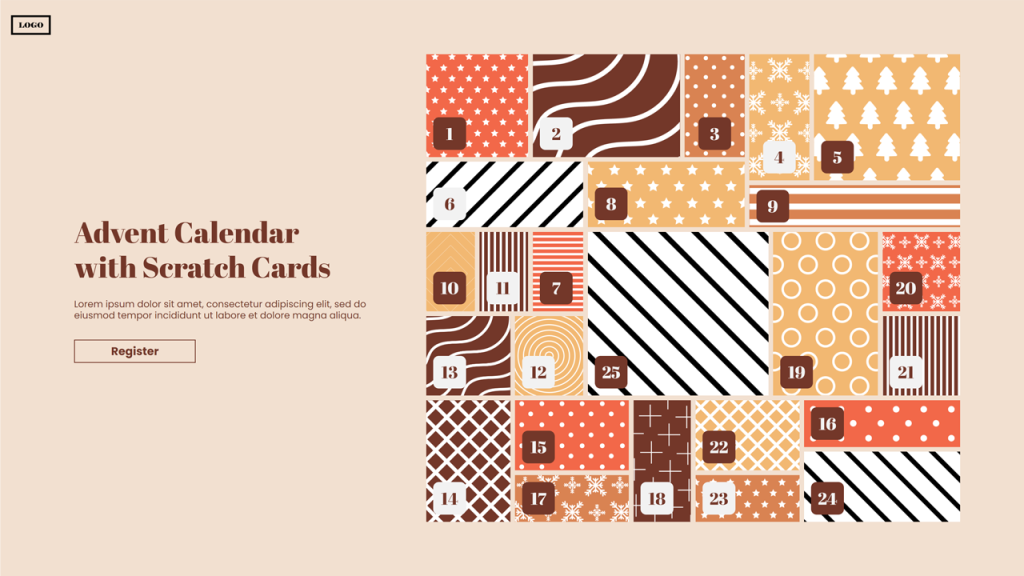
7. Marketing Games
What’s the best way to gain people’s attention? Games. We all love playing games to relax our minds. That’s why Marketing Games are so successful, and you should implement them in your marketing strategy today.
There are many different types of Marketing Games. For example, you have simple games like puzzles, scratch cards, memory games, etc. They are excellent to entertain your audience on social media or your website, cutting the clutter, and differentiating yourself from competitors.
If your goal is to grow your email list, adding a contest with a gated lead form to your Marketing Games would be an excellent idea. If you want to see remarkable results, you can also incentivize participation with instant gratification. By making an instant-win contest, you’ll create an even stronger incentive.
Incorporating Marketing Games into your strategy isn’t just about fun; it’s a strategic move to enhance your audience’s interaction and boost your marketing impact.
Main benefits of Marketing Games: entertain your audience, increase awareness, boost engagement, and grow your email list
Example: This Tapping Game with Leaderboard is a fun activity to engage and challenge your customers.

8. Interactive Conversation
Interactive Conversations are often compared to chatbots, but they are actually way better because they use voices, images, animations, or videos rather than only text. Using/ implementing Interactive Conversations is a cost-effective way to engage with your visitors and automate customer service 24/7. Plus, in this type of Interactive Content, you can set the tone. You can appear friendly, knowledgeable, trustworthy, and so on. Therefore, this is an incredible Interactive Experience type to improve your brand image.
Moreover, Interactive Conversations are amazing tools to learn more about potential customers. What are they looking for? What are their pain points? How can you help them best? And so on. You can use this amazing Interactive Content example to narrow your sales funnel and provide your Sales Team with valuable information on the potential clients they are meeting with. Plus, you can add a lead form at the end of your Interactive Conversations to grow your email list, or allow them to directly book a meeting to boost conversions.
Main benefits of Interactive Conversation: boost engagement, improve brand image, collect valuable data, grow your email list, and increase conversions.
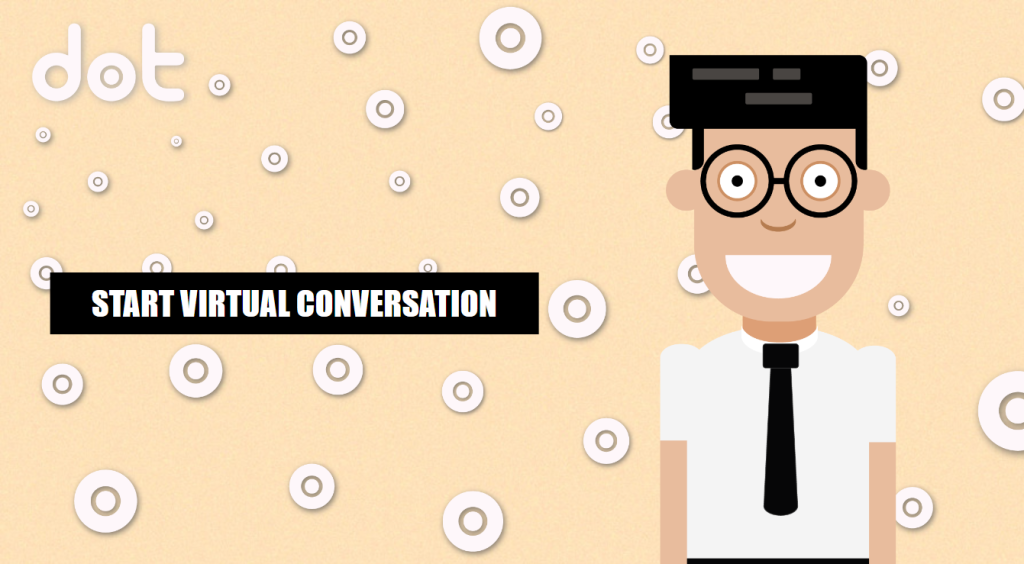
9. Interactive Infographics
Interactive Infographics are infographics where you add interactive elements such as pop-ups, interactive graphics, quizzes, Interactive Videos, etc. So, in the end, you have an enhanced Interactive Experience that increases awareness and engagement.
The interactive elements you add to your infographics depend on what types of Interactive Infographics you want to design. For example, if you want to design a timeline infographic, you could think of adding textual pop-ups to add more details without overcrowding the design. In a How-to Infographic, also called Process Infographic, you could have pop-ups of videos to explain each step more thoroughly.
Main benefits of Interactive Infographics: increase awareness, boost engagement, and educate your audience
Example: This is an out-of-the-box product infographic with an embedded Product Recommender.
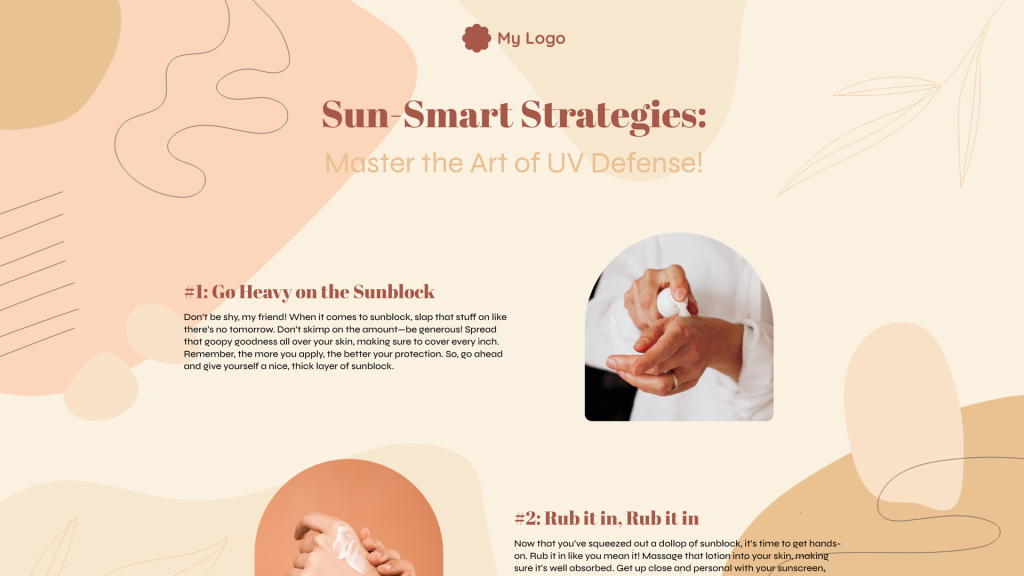
10. Interactive Flipbooks
Interactive Flipbooks are simply amazing. With this Interactive Content type, you can re-use your old and boring PDFs and turn them into a stunning flipbook with interactive elements.
There are many different types of Interactive Flipbooks. Depending on the type, you can decide to add as many interactive elements as you want. Adding animations, quizzes, videos, calculators, games, Product Recommenders, etc., will enhance your website visitors’ experience. They’ll be way more inclined to read your PDFs now, and they will also retain the information better.
Yet, the best feature of an Interactive Flipbook is its analytical properties. You’ll be able to learn what sections people read and what interactive elements they engage with. Therefore, you’ll be able to optimize your Interactive Flipbook. You can also gate specific sections with a lead form to grow your email list.
Main benefits of Interactive Flipbooks: boost engagement, educate your audience, collect valuable data, grow your email list, and increase conversions
Example: This Product Catalog Flipbook – B2B/ Food helps visitors navigate through your menu card and find the best menu based on their preferences.
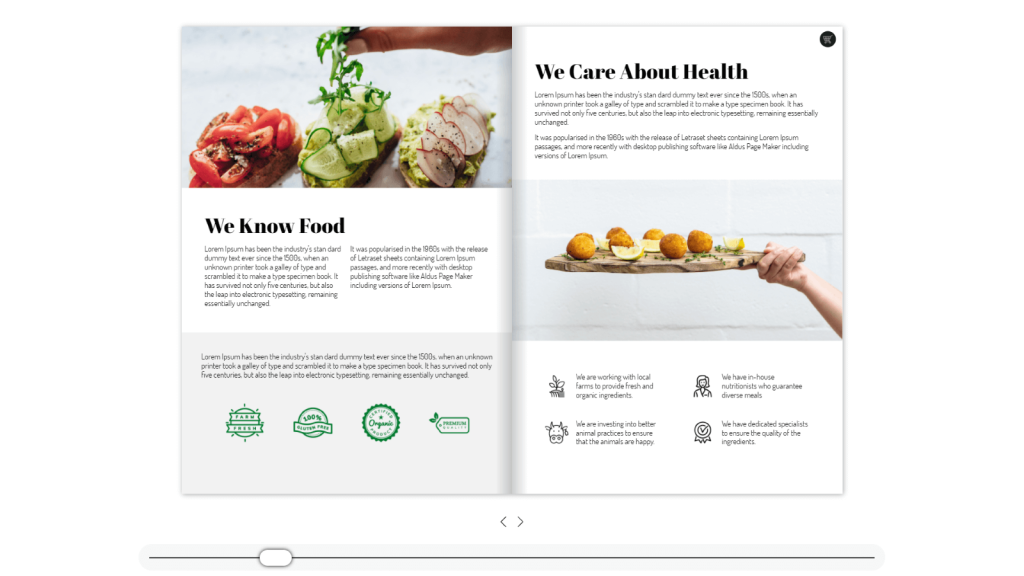
11. Interactive Calculators
Calculators are amazing types of Interactive Content to embed into your website. There are many different types of Interactive Calculators. For example, visitors can use them to calculate a specific price depending on custom preferences or the ROI of an investment. They can also determine the potential savings by opting for your product or software, or even assess the weight they could shed by embracing your exercise and diet program.
In other words, the utilities of Interactive Calculators are extremely versatile and depend on your needs. But, if we generalize, we can say that Interactive Calculators are great for educating your customers on their options. Moreover, they are often used to convince potential customers, so they are great for boosting sales and increasing conversions.
Main benefits of Interactive Calculators: boost engagement, improve user experience, educate your audience, boost sales, increase conversions
Example: This Product Calculator helps potential customers make informed decisions.
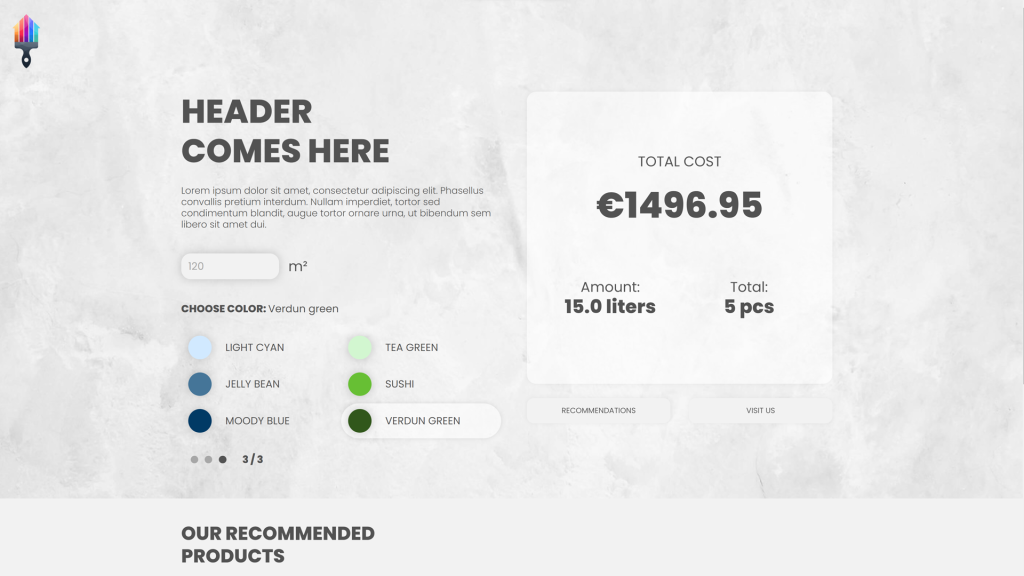
12. Interactive Popups
Interactive Popups are one of the newest types of Interactive Content. While most website popups are intrusive and irrelevant, adding a touch of interactivity can make all the difference. For instance, you can create a Product Recommender that loads as a popup after a visitor has been browsing product pages for more than 5 minutes.
You can embed any of the Interactive Content examples from this blog post in a popup. With modern technology, you can target and personalize content to your visitors like never before.
Depending on your purpose, there are different types of popups to consider for your website: from inactivity notifications to complex gamified experiences and countdown calculators.
Main benefits of Interactive Popups: complete the customer journey, improve user experience, boost sales
Example: This gamified popup challenges your visitors to guess the price of an item and win a prize.

3 Real-life Interactive Content examples
Now, let’s see how successful brands use Interactive Content.
1. Scratch & Win – Marketing Game
Barry Callebaut, the world’s leading supplier of high-quality chocolate and cocoa products, used a Marketing Game to entertain customers at a major food fair event. Simple yet engaging, the game invited players to scratch three chocolate bags in hopes of winning a product sample. The campaign delivered amazing results: more than 300 new leads and 30% conversion rates.
Learn more about the way Barry Callebaut implemented gamification with their Scratch & Win game.
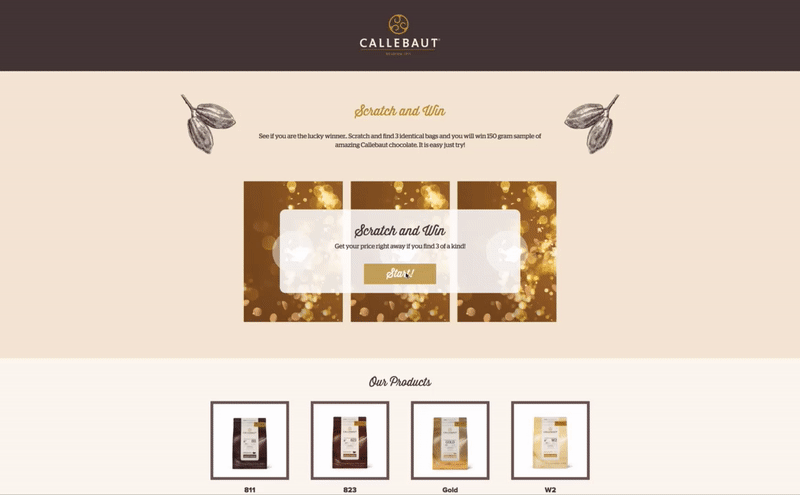
2. Interactive Advent-style Calendar – Online Advent Calendar
Color Street, a revolutionary beauty brand, collaborated with Dot.vu to create an Online Advent Calendar packed with games, quizzes, videos, giveaways, and sneak peeks of their upcoming collections. Built in less than two weeks, the campaign was a remarkable success, with more than a million visitors and 30 000 leads.
Read more about the Interactive Advent-style Calendar and get inspired.
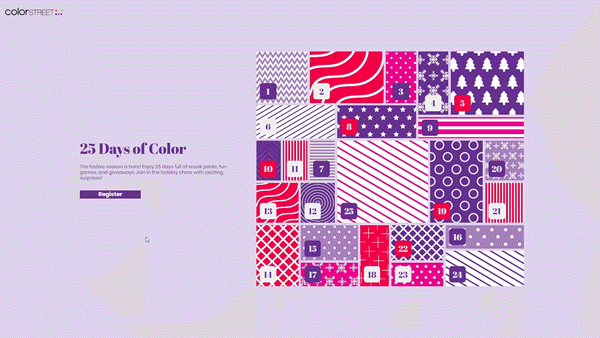
3. Different Product Finders for cosmetic and health products
Superdrug, one of the biggest health and beauty retailers in the UK, launched a diverse range of Product Finders on their website. These included routine finders, prescription medication finders, skincare finders, and Cerave finders. Guiding online shoppers toward the right products helped increase conversion rates 5 times!
Still in doubt? Use our Interactive Experience Finder to discover the Interactive Content type that best fits your needs:

Get inspired to create an Interactive Content campaign
Looking for inspiration? Try this Template Idea Generator to get inspired for your next project:
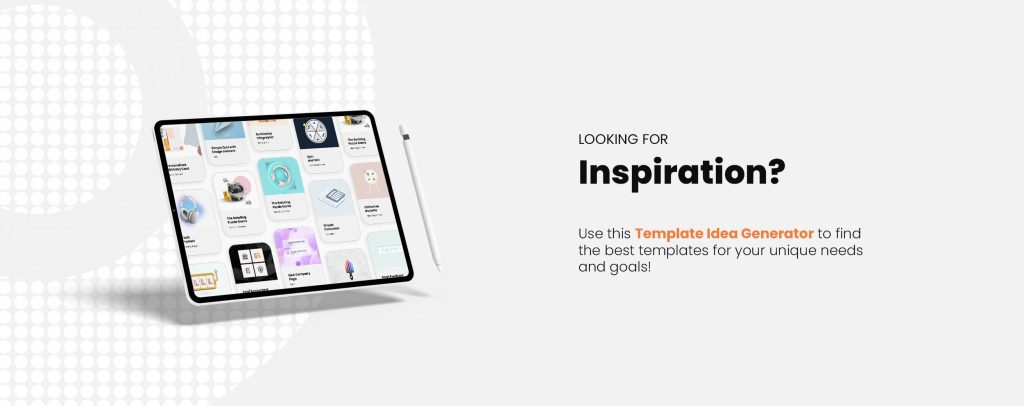
Start creating Interactive Content with Dot.vu!
Interactive Content is the future of marketing. That’s why, at Dot.vu, we worked really hard to build the most extensive and easy-to-use Interactive Content platform with more than 20 types of Interactive Content. No coding. No hassle – just creativity and results.
While these 12 Interactive Content examples showcase the possibilities, there’s an abundance of Interactive Content ideas waiting to be created on Dot.vu. Your imagination is the only limit. Get started by creating a free account, giving you access to 300+ templates and infinite possibilities.
